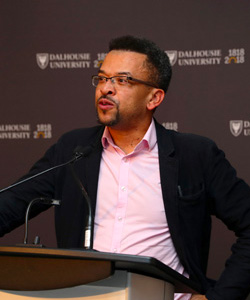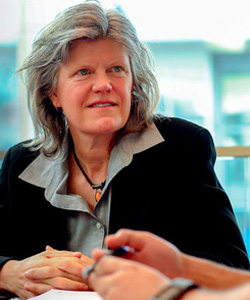Some of the easiest ways to think about diversity focus on questions of “who.” Who is present within a space? Who has a seat at the table? Who is given the opportunity to speak — and who is listened to? Questions of “who” can also be documented and reported on, turned into numbers and figures, with relative ease.
But if diversity stops at “who,” it misses other questions every bit as crucial, like “what” and “how.”
“It’s about getting beyond the numbers,” says Dal Provost Teri Balser. “Numbers are easier to monitor, but metrics and targets don’t get at the heart of what diversity is, and its value.”
For a university, that means thinking about more than just enrolment numbers and faculty complement — important as those are — and diving into what happens in the classroom, at the heart of the academic experience.
These days, questions of “diversifying” or “decolonizing” curriculum are top-of-mind in higher education, both as an effort to develop courses and programs to better reflect the growing diversity in universities, and also to challenge systemic biases inherent in the largely white, Eurocentric systems of knowledge that have shaped the history of Western universities.
Pushing for change
For Senate Chair Kevin Hewitt, curriculum diversity has been something he’s been pushing for most of his life.
 “As a member of the African Canadian community, this has been a battle — in the school system, for my kids to have a diverse, inclusive curriculum, and in my own experience as a student and faculty member,” he says.
“As a member of the African Canadian community, this has been a battle — in the school system, for my kids to have a diverse, inclusive curriculum, and in my own experience as a student and faculty member,” he says.
During graduate studies at Simon Fraser University, Dr. Hewitt and his peers pushed the administration to encourage a more inclusive curriculum, even organizing their own 12-part lecture series, “Missing: Pieces of the African Heritage Puzzle,” to try and bring diverse perspectives across different disciplines to campus. “Going through that process, you realize that diversifying the curriculum doesn’t mean, ‘Oh, we’ll add a course here where we’ll put all the diverse perspectives, and you can take it or not.’”
To illustrate his point, Dr. Hewitt pulls out his copy of The Equity Myth: Racialization and Indigeneity at Canadian Universities, a 2017 book that counts Dal sociologist Howard Ramos among its authors. He flips to a chapter from the University of Alberta’s Melina Smith, quoting Harry Garuba of the University of Cape Town.
“Do we simply add new items to an existing curriculum – rather like adding raffia chairs to the master’s living room?” writes Dr. Garuba. “Or do we adopt the reverse approach in which we rethink how the object of study itself is constituted?”
“[Diversity is] not an add on,” says Dr. Hewitt in response. “It’s embedding it in the curriculum, in syllabuses across the university . . . It’s diversity infrastructure — part of the foundation of what we do.”
Asking the right questions
Of course, making changes to a foundation isn’t necessarily easy. In the case of curriculum, and trying to make it more diverse, it means a conversation that’s different in every course, every discipline, every faculty. And it’s a full of intersectional terms with lots of room for interpretation and meaning: diversifying, decolonizing, indigenizing.
 For Dr. Balser, new to Dalhousie but who has worked on these sorts of issues in previous roles in Australia, she sees enthusiasm growing for those conversations among deans, faculty members and students.
For Dr. Balser, new to Dalhousie but who has worked on these sorts of issues in previous roles in Australia, she sees enthusiasm growing for those conversations among deans, faculty members and students.
“The question is, what kind of goals do we want to set, institution-wide? It’s clear that diversifying curriculum is the right thing to do, but we need to explore what it will mean to us as a university and to the wide variety of disciplines within Dal.”
The deans have a key leadership role to play in that process, and Dr. Balser says she’s eager to work with them on how those conversations can flow down through faculty councils — appreciating that what a diverse curriculum would mean for a medicine program, for example, might be different than in physics or English.
Meanwhile, on a university wide level, Senate has a crucial role as well. At each of its meetings, Senate invites a guest to deliver a five-minute presentation on diversity and inclusion topics, helping raise awareness and understanding among senators. This year, those presentations are focused on curriculum issues.
Senate is also in the process of organizing an open forum on curriculum diversification, set to take place this fall, that will invite national and local speakers to campus to help further increase awareness and understanding around the issues.
Creating a stronger university
Dr. Balser says she’s hopeful that, working across the university, there are some easy gains to be made towards encouraging diversity in curriculum, but also acknowledges that getting these conversations right will take time. Dr. Hewitt agrees.
“Because it’s a longstanding problem, it’s going to take a long time to fix,” he says. “But we need attention to it — and crucially, equity and inclusion requires resources, too, in order to address longstanding problems.” He, specifically, cites the importance of faculty diversity: “The ultimate solution is to have a diverse faculty complement.”
The end result, he hopes, will be a stronger, more supportive university.
“If we actually accomplish the goal of diversifying the curriculum across all our faculties, then what we’ll see, I think, is students feel a greater sense of belonging, because they’ll see themselves reflected in it,” he says.
“We need all minds,” says Dr. Balser. “We have a lot of challenges we’re facing as a society, as communities — complex, difficult things like climate change, like socio-political changes. These are tough issues, and I truly believe we need all minds working on them, everybody’s different perspectives. Because every place I’ve been, in every place I’ve taught, together we come up with more, better solutions than any one of us can individually.
“That’s the underlying philosophy of it all: together, we’re better.”

